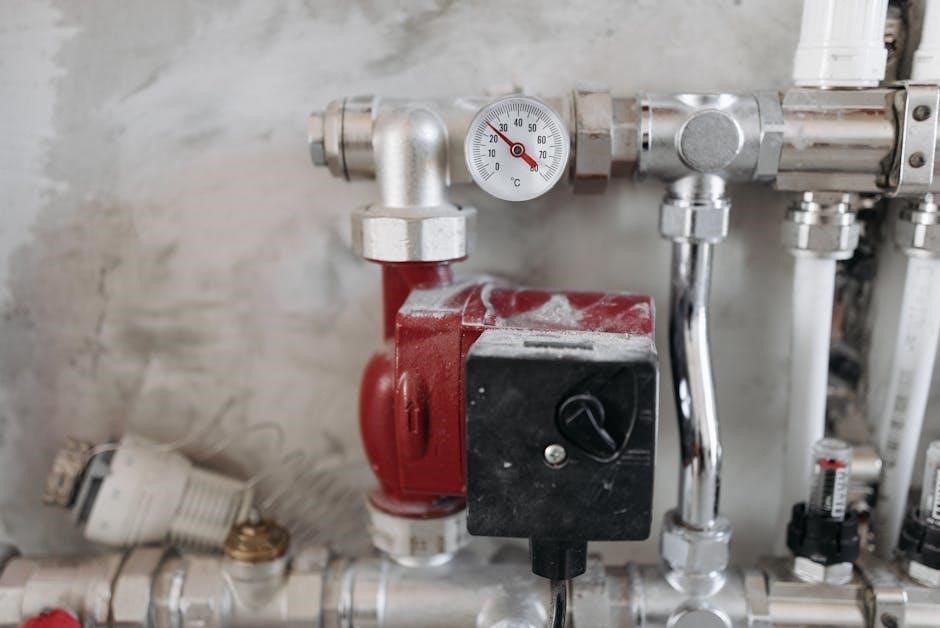Valve guides play a crucial role in engine operation by aligning valve stems and preventing oil leakage. Their failure leads to symptoms like excessive oil consumption and visible smoke emissions.
Overview of Valve Guides in Engine Operation
Valve guides are essential components in an engine, serving as the pathway for valve stems to move up and down. They ensure proper alignment and smooth operation of the valves, which are critical for air-fuel mixture intake and exhaust gas expulsion. By maintaining precise movement, valve guides prevent excessive wear on other components and help sustain engine efficiency. They also play a role in preventing oil leakage into the combustion chamber by guiding the valve stems securely. Over time, wear on valve guides can lead to issues such as improper valve seating, increased oil consumption, and visible smoke emissions. Regular inspection and maintenance of valve guides are vital to uphold engine performance and longevity, as neglected wear can escalate into more severe damage. Their function is integral to the overall health and reliability of the engine.

The Role of Valve Guides in Maintaining Engine Efficiency
Valve guides are critical for ensuring proper valve operation, which directly impacts engine efficiency. By guiding the valve stems precisely, they maintain accurate alignment, enabling valves to open and close effectively. This precise movement is essential for efficient air-fuel intake and exhaust expulsion. When valve guides function correctly, they minimize unnecessary wear on other components, such as valve seats and stems, which helps preserve engine performance. Additionally, they prevent excessive oil from entering the combustion chamber, reducing the risk of oil burns and maintaining optimal fuel efficiency. If valve guides wear out, they can disrupt valve operation, leading to reduced engine efficiency, poor performance, and increased oil consumption. Regular maintenance and inspection of valve guides are vital to uphold their role in sustaining engine efficiency and overall functionality. Their proper condition ensures the engine operates smoothly and maintains its designed performance levels.

Common Symptoms of Bad Valve Guides
Bad valve guides often cause excessive oil consumption, blue or grayish smoke from the exhaust, engine noise or tapping sounds, difficulty starting the engine, and various performance issues.
Excessive Oil Consumption
Excessive oil consumption is a common symptom of bad valve guides. When valve guides wear out, they allow engine oil to seep into the combustion chamber, leading to increased oil usage. This issue is often noticeable when the engine is under load or during prolonged driving sessions. Drivers may observe that the oil level drops more frequently than usual, requiring more frequent refills. If left unchecked, this can lead to increased maintenance costs and potential damage to other engine components. It is important to address this issue promptly, as excessive oil consumption can also indicate other related problems with the engine’s valve train system. Regular monitoring of oil levels and performance can help identify this issue early, preventing further complications. Always consult a mechanic if excessive oil consumption is suspected, as they can perform diagnostic tests to confirm the cause. Early intervention is key to maintaining engine health and efficiency.
Blue or Grayish Smoke from the Exhaust
Blue or grayish smoke emanating from the exhaust is a noticeable symptom of bad valve guides. This occurs when engine oil seeps into the combustion chamber due to worn or damaged guides. The oil, when burned, produces a distinct blue or gray smoke, especially during startup, idling, or acceleration. This issue is often more pronounced when the engine is under load or after extended periods of idling. If left unaddressed, the excessive oil burning can lead to further engine damage, such as fouled spark plugs or increased wear on valves and seats. Additionally, this symptom is often accompanied by excessive oil consumption, as the engine burns more oil than usual. It is crucial to inspect and repair faulty valve guides promptly to prevent escalating engine problems and maintain optimal performance.
Engine Noise or Tapping Sounds
One of the most common indicators of bad valve guides is unusual engine noise, often described as tapping, clattering, or knocking sounds. This noise occurs when the valve stems move excessively within worn or damaged guides, creating abnormal clearance. The sounds are typically more pronounced when the engine is cold or under load. As the engine operates, the valves may vibrate or rock due to the lack of proper guidance, leading to these audible symptoms. Over time, this excessive movement can cause further wear on the valves and seats, exacerbating the issue. If left unaddressed, the noise may become more intense and frequent, signaling the need for immediate inspection and repair. Early detection of these sounds can help prevent more severe engine damage, making it essential to investigate and address the problem promptly. Regular maintenance and inspections are key to identifying such issues before they escalate.

Difficulty in Starting the Engine
Bad valve guides can make it challenging to start the engine, especially when cold. This is often due to excessive oil entering the combustion chamber, which can foul the spark plugs or create a “wet” effect, reducing the spark’s effectiveness. The engine may require multiple turns of the ignition to fire up, or it might stall shortly after starting. Over time, this issue can become more persistent, leading to frustration and increased wear on the starter and battery. The problem is particularly noticeable in the morning or after extended periods of inactivity, as the oil has more time to seep into areas it shouldn’t. While the engine may run normally once started, persistent starting issues should be investigated promptly to prevent further damage to the valve train or related components. Addressing the root cause, such as worn valve guides, is essential for restoring reliable engine performance.
Engine Performance Issues
Bad valve guides can lead to noticeable engine performance issues, including rough idling, misfires, and a general lack of power. When valve guides wear out, they allow excessive movement of the valve stems, disrupting the precise timing of the engine’s combustion process. This can result in a decrease in compression, reducing the engine’s efficiency and overall performance. Drivers may experience hesitation or stumbling during acceleration, particularly under load. Additionally, worn valve guides can cause inconsistent fuel delivery and ignition, further exacerbating performance problems. Over time, these issues can lead to decreased fuel efficiency and a decline in the engine’s ability to maintain smooth operation. Addressing valve guide problems early is crucial to preventing more severe damage and restoring optimal engine functionality.

Diagnosis and Inspection of Valve Guides
Diagnosis involves visual inspection for wear, checking oil buildup around guides, and performing a leak-down test to identify internal leaks, ensuring early detection and repair of issues.

Visual Inspection of Valve Guides
A visual inspection of valve guides involves removing the valve cover to access the guides. Look for signs of wear, such as excessive play in the valve stems or visible damage to the guide surfaces. Worn guides may appear scored or discolored. Check for movement in the valve stem by gently rocking it back and forth; excessive movement indicates worn guides. Additionally, inspect for oil residue or buildup around the guides, as this can signal leakage. A clean, functioning guide should show minimal to no movement and no signs of oil seepage. This step is crucial for identifying issues early, preventing further engine damage; A thorough visual inspection can often reveal problems before they escalate, making it a vital part of routine engine maintenance.
Checking for Oil Buildup Around Valve Guides
Oil buildup around valve guides is a clear indicator of wear. During inspection, look for excessive oil residue or sludge accumulation near the valve guide area. This occurs when oil seeps past worn guides into the combustion chamber. To check, remove the valve cover and inspect the area around each guide. Use a clean, lint-free cloth to wipe away any visible oil or debris. If the guides are worn, oil will continue to accumulate, even after cleaning. In severe cases, this can lead to blue or grayish smoke from the exhaust, especially during startup or deceleration. Regularly checking for oil buildup helps identify potential issues early, preventing more severe engine damage. This simple step is a key part of maintaining engine health and efficiency.

Using a Leak-Down Test to Identify Issues

A leak-down test is an effective method to diagnose valve guide problems. This test involves pressurizing a cylinder and listening for escaping air, which indicates internal engine leaks. If the valve guides are worn, air may escape through the valve stem area, producing a distinct hissing sound. The test helps pinpoint the exact source of the leak, whether it’s from the guides, seals, or other components. A significant leak near the valve guides suggests wear or damage, requiring immediate attention. This diagnostic tool is crucial for assessing the severity of valve guide issues and determining the necessary repairs. Regular leak-down tests can help maintain engine performance and prevent further damage from worn guides.

Consequences of Neglecting Bad Valve Guides
Neglecting worn valve guides leads to increased engine wear, potential damage to valves and seats, and reduced performance over time, ultimately requiring costly repairs if left unaddressed.

Increased Engine Wear and Tear
Worn valve guides accelerate engine wear by allowing excessive oil to enter combustion chambers, leading to blue or gray smoke and engine noise. Over time, this causes premature wear on critical components like piston rings and cylinder walls.
The movement of valves within worn guides creates friction and heat, further damaging engine parts. Neglecting this issue can result in costly repairs, as the engine’s overall structure deteriorates due to prolonged stress and inefficiency.
Potential Damage to Valves and Seats
Bad valve guides can cause excessive movement of the valves, leading to improper seating and potential damage to the valves and their seats. This misalignment can result in burns or wear on these critical components.
- Valve seats may become pitted or cracked due to uneven stress.
- Valves can develop burn marks or excessive wear from improper alignment and heat buildup.
Over time, this damage can lead to reduced engine performance and require costly repairs, including valve and seat replacement. Addressing valve guide issues early is essential to prevent further deterioration.
Reduced Engine Performance Over Time
Bad valve guides gradually degrade engine performance by allowing oil to enter the combustion chamber and reducing compression efficiency. This leads to power loss and decreased fuel efficiency.
- Increased oil consumption strains engine resources and adds maintenance costs.
- Smoke emissions indicate oil burning, which can foul spark plugs and damage catalytic converters.
Ignoring valve guide issues accelerates wear on other components, leading to poor acceleration and rough idling. Regular inspections and timely repairs are crucial to maintain optimal engine health and avoid more severe damage.
Recognizing symptoms of bad valve guides early is crucial for preventing further engine damage. Prompt inspection and necessary repairs ensure optimal performance and longevity of your vehicle’s engine.
Importance of Addressing Valve Guide Issues
Addressing valve guide issues is essential for maintaining engine health and performance. Ignoring worn or damaged valve guides can lead to increased engine wear, reduced efficiency, and potentially costly repairs. Over time, faulty guides allow oil to leak into combustion chambers, causing excessive smoke emissions and decreased fuel efficiency. Additionally, improper alignment from worn guides can damage valve seats and stems, leading to more severe engine problems. Early detection and repair of valve guide issues ensure smoother engine operation, better fuel efficiency, and prolonged engine lifespan; Regular inspections and timely maintenance are critical to preventing these issues from escalating. By addressing valve guide problems promptly, you can avoid more complex and expensive fixes down the road, ensuring your engine runs optimally for years to come.
Recommended Repairs and Maintenance
When dealing with bad valve guides, it’s crucial to address the issue promptly to prevent further damage. The primary repair involves replacing the worn guides and possibly the valve stems. Mechanics often recommend resurfacing or replacing the valve seats to ensure proper sealing and engine performance. In some cases, especially with severe wear, installing new valves may be necessary. Regular maintenance, such as checking valve lash and inspecting for oil buildup, can help identify issues early. Preventative measures include using high-quality lubricants and ensuring proper engine tune-ups. Repairing valve guides requires specialized tools and expertise, so consulting a professional is advised. By taking these steps, you can restore engine efficiency, reduce oil consumption, and eliminate smoke emissions, ensuring reliable performance for years to come. Consistent upkeep is key to maintaining optimal engine health and avoiding costly future repairs.
